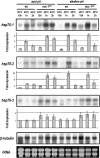Transcription of the Neurospora crassa 70-kDa class heat shock protein genes is modulated in response to extracellular pH changes
- PMID: 19618296
- PMCID: PMC2866986
- DOI: 10.1007/s12192-009-0131-z
Transcription of the Neurospora crassa 70-kDa class heat shock protein genes is modulated in response to extracellular pH changes
Abstract
Heat shock proteins belong to a conserved superfamily of molecular chaperones found in prokaryotes and eukaryotes. These proteins are linked to a myriad of physiological functions. In this study, we show that the N. crassa hsp70-1 (NCU09602.3) and hsp70-2 (NCU08693.3) genes are preferentially expressed in an acidic milieu after 15 h of cell growth in sufficient phosphate at 30 degrees C. No significant accumulation of these transcripts was detected at alkaline pH values. Both genes accumulated to a high level in mycelia that were incubated for 1 h at 45 degrees C, regardless of the phosphate concentration and extracellular pH changes. Transcription of the hsp70-1 and hsp70-2 genes was dependent on the pacC (+) background in mycelia cultured under optimal growth conditions or at 45 degrees C. The pacC gene encodes a Zn-finger transcription factor that is involved in the regulation of gene expression by pH. Heat shock induction of these two hsp genes in mycelia incubated in low-phosphate medium was almost not altered in the nuc-1 (-) background under both acidic and alkaline pH conditions. The NUC-1 transcriptional regulator is involved in the derepression of nucleases, phosphatases, and transporters that are necessary for fulfilling the cell's phosphate requirements. Transcription of the hsp70-3 (NCU01499.3) gene followed a different pattern of induction-the gene was depressed under insufficient phosphate conditions but was apparently unaffected by alkalinization of the culture medium. Moreover, this gene was not induced by heat shock. These results reveal novel aspects of the heat-sensing network of N. crassa.
Figures





References
Publication types
MeSH terms
Substances
LinkOut - more resources
Full Text Sources
Miscellaneous

